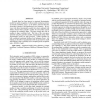Free Online Productivity Tools
i2Speak
i2Symbol
i2OCR
iTex2Img
iWeb2Print
iWeb2Shot
i2Type
iPdf2Split
iPdf2Merge
i2Bopomofo
i2Arabic
i2Style
i2Image
i2PDF
iLatex2Rtf
Sci2ools
ICASSP
2011
IEEE
2011
IEEE
Structured discriminative models for noise robust continuous speech recognition
Recently there has been interest in structured discriminative models for speech recognition. In these models sentence posteriors are directly modelled, given a set of features extracted from the observation sequence, and hypothesised word sequence. In previous work these discriminative models have been combined with features derived from generative models for noise-robust speech recognition for continuous digits. This paper extends this work to medium to large vocabulary tasks. The form of the score-space extracted using the generative models, and parameter tying of the discriminative model, are both discussed. Update formulae for both conditional maximum likelihood and minimum Bayes’ risk training are described. Experimental results are presented on small and medium to large vocabulary noise-corrupted speech recognition tasks: AURORA 2 and 4.
| Added | 20 Aug 2011 |
| Updated | 20 Aug 2011 |
| Type | Journal |
| Year | 2011 |
| Where | ICASSP |
| Authors | Anton Ragni, Mark John Francis Gales |
Comments (0)

